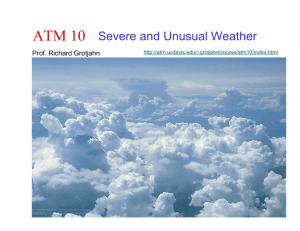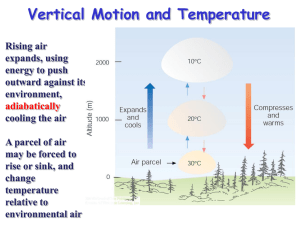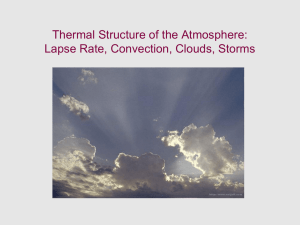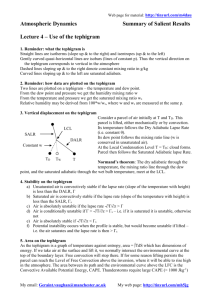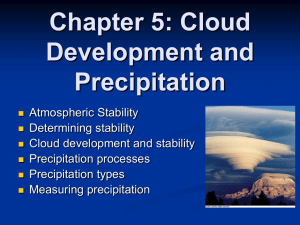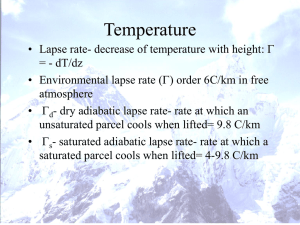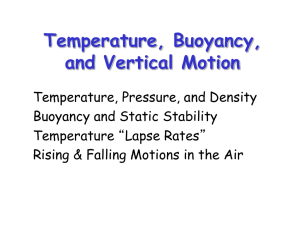dry-adiabatic lapse rate
advertisement
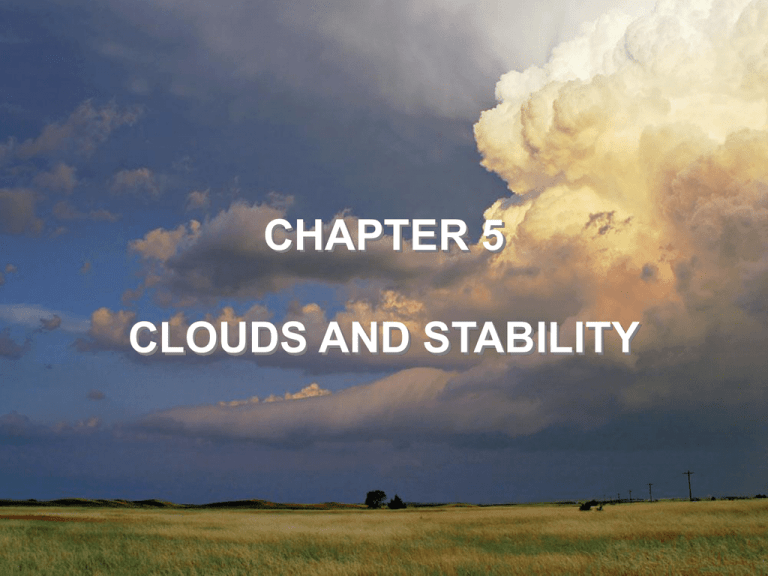
CHAPTER 5 CLOUDS AND STABILITY Remember that rising air expands and cools, and sinking air compresses and warms When this happens in unsaturated conditions, it is called an adiabatic process – no heat is gained or lost This is reversible – the air parcel has the same temperature at the beginning and end But what happens if at some point along its path the parcel becomes saturated, and a cloud forms? (more on this in a minute…) Simple definition: the condition is stable if an object, when forced to move, will tend to move back to its original position If it tends to continue moving away from its original position, it is unstable In atmospheric science, we often consider the motions of air parcels, which can heat and cool but do not mix in air from the outside Rising parcels expand and cool, sinking parcels are compressed and warm At the same height, warm air is less dense than cool air An unsaturated (dry) parcel will always rise and sink at 9.8°C per km – the dry-adiabatic lapse rate For the sake of discussion today, we’ll just use the round value of 10 °C per km for the dryadiabatic lapse rate Stepped Art Fig. 5.2, p. 123 Moist parcels • When parcels rise and cool, they will eventually become saturated • As they continue to rise, the water vapor will condense into liquid water – a cloud • Remember what happens during condensation: latent heat is released inside the parcel • So, instead of cooling at 10°C per km, it cools slower – usually around 6°C per km – this is the moist-adiabatic lapse rate Table 5.1, p. 123 Parcels (individual bubbles of air) always rise and sink at either the dry or moist adiabatic rate The environment (the air surrounding the parcel) can have a variety of temperature profiles This environmental rate is measured with radiosondes (on weather balloons) Since the adiabatic lapse rates are known, we can compare them to the environmental lapse rate to determine whether the parcel will be stable or unstable ◦ If a parcel is forced to rise, and it’s warmer than its environment, it will continue to rise: unstable ◦ If it is forced to rise and is cooler than its environment, it will sink back down to the original position: stable When the environmental lapse rate is less than the moist adiabatic rate (6°C/km) ◦ All parcels will be colder than their environment and sink back to their original position Example: temperature inversion (temperature increases with height) – acts as a lid Often occurs at night due to radiational cooling When environmental lapse rate equals the dry-adiabatic lapse rate Unsaturated parcels will not tend to rise or sink in this condition – they tend to stay where they are If environmental lapse rate equals moistadiabatic lapse rate, then the atmosphere is neutrally stable for saturated parcels When the environmental lapse rate is greater than the dry-adiabatic lapse rate ◦ All parcels will be warmer than their environment and continue to rise This condition usually only occurs near the surface, and not for very long – the rising parcels will bring the warm air up and cool air will mix down around them No need for a helicopter here! But this would also never happen! When the environmental lapse rate is between the dry and moist adiabatic lapse rates ◦ Unsaturated parcels will sink back to their original position, saturated parcels will continue to rise There is instability, on the condition that the parcel is saturated On average, the atmosphere is in this state (average environmental lapse rate = 6.5°C/km) This helps to explain why cumulus clouds can grow very tall (into cumulonimbus) – only saturated parcels continue to rise Need the helicopter here But not here Fig. 5.10, p. 130 Warming at low levels or cooling aloft: increases lapse rate, makes atmosphere less stable ◦ “Warm air advection” at low levels will destabilize the atmosphere Mixing ◦ If absolutely unstable, mixing will make atmosphere more stable ◦ If stable, mixing can make atmosphere unstable Lifting or subsidence in layers If a whole layer sinks, it compresses in the denser air near the ground, top warms more than bottom, and becomes more stable If a whole layer rises, it stretches in the lessdense air aloft, and it tends to become more unstable, especially when the bottom is saturated and the top is dry – convective instability In real life, we don’t have helicopters pulling parcels of air up and down…so what causes air to rise and sink? Lifting Condensation Level (LCL) : level at which condensation occurs – this represents the cloud base ◦ Force an unsaturated parcel to rise from the surface ◦ Temperature will decrease by 10 °C per km, dew point by 2 °C per km until saturated ◦ At the point where the T and Td are equal, the parcel is saturated, water can condense, and a cloud can form (T and Td will fall at the same rate above this) ◦ Handy formula: LCL = 125 (T-Td), where T and Td are in Celsius, and LCL will be in meters Stepped Art Fig. 5.16, p. 134 Level of Free Convection (LFC) : level at which air will continue to rise without forcing ◦ Force an unsaturated parcel to rise from the surface ◦ Calculate how the temperature cools with height (using dry adiabatic rate when unsaturated, moist adiabatic when saturated) ◦ Find the point where the parcel’s temperature becomes warmer than its environment – above this point, it will rise freely Equilibrium level (EL): level above the LFC at which the air will stop rising ◦ Continue the process that you used for the LFC and find the point at which the parcel’s temperature becomes equal to or cooler than the environmental temperature If the atmosphere is very unstable, this level can be very high, and this situation is conducive to deep cumulonimbus development Nashville, TN North Platte, NE Nashville, TN North Platte, NE Mountains can provide the lifting required to bring air to its LCL and/or LFC On the windward side, clouds often form and rain/snow is common On the leeward side there is sinking motion – a “rain shadow” If unsaturated, temperature will be the same at start and finish But if saturation is reached…this is no longer reversible Heat is released in condensation In stable conditions above a mountain, waves can set up in the airflow Clouds can form on the upward parts of the waves, and they appear to be stationary (standing wave clouds) They sometimes take a “flying saucer” appearance Lenticular wave clouds SPECIAL TOPIC • Subsidence Inversions – Strong subsidence exacerbates air pollution due to the lack of vertical motion – Pollution is not diluted FOCUS • Lake Effect Snow (Great Lakes) – Snowstorms that form on the downwind side of one of these lakes are known as lake effect snows – Cold air moves over the lakes when they are relatively warm and not quite frozen – Water vapor absorbed – Becomes snow on edge of lake • Rising motion due to heat addition and slowing/terrain Lake Effect Snow CLOUD DEVELOPMENT • Changing cloud forms – Stratus clouds can change to cumulus clouds if the top of the cloud cools and the bottom of the cloud warms – Altocumulus castellanus: castle-like towers on altocumulus – If moist stable air without clouds is mixed or stirred it can form stratocumulus clouds. Fig. 5.25, p. 140 Fig. 5.26, p. 141
